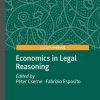Dalhuisen on Transnational Comparative Commercial Financial and Trade Law Volume 1 The Transnationalisation of Commercial and Financial Law and of Commercial Financial and Investment Dispute Resolution The New Lex Mercatoria and its Sources Dalhuisen 1782251146 9781782251149
$50.00 Original price was: $50.00.$25.00Current price is: $25.00.
This completed downloadable of Dalhuisen on Transnational Comparative Commercial Financial and Trade Law Volume 1 The Transnationalisation of Commercial and Financial Law and of Commercial Financial and Investment Dispute Resolution The New Lex Mercatoria and its Sources Jan H. Dalhuisen

Instant downloaded Dalhuisen on Transnational Comparative Commercial Financial and Trade Law Volume 1 The Transnationalisation of Commercial and Financial Law and of Commercial Financial and Investment Dispute Resolution The New Lex Mercatoria and its Sources Jan H. Dalhuisen pdf docx epub after payment.
Product details:
- ISBN 10: 1782251146
- ISBN 13: 9781782251149
- Author: Jan H. Dalhuisen
This is the fifth edition of the leading work on transnational and comparative commercial and financial law, covering a wide range of complex topics in the modern law of international commerce, finance and trade. As a guide for students and practitioners it has proven to be unrivalled. Since the fourth edition, the work has been divided into three volumes, each of which can be used independently or as part of the complete work. Volume one covers the roots and foundations of private law; the different orientations and structure of civil and common law; the concept, forces, and theoretical basis of the transnationalisation of the law in the professional sphere; the autonomous sources of the new law merchant or modern lex mercatoria, its largely finance-driven impulses; and its relationship to domestic public policy and public order requirements. Volume two deals with transnational contract, movable and intangible property law. Volume three deals with financial products and financial services, with the structure and operation of modern commercial and investment banks, and with financial risk, stability and regulation, including the fall-out from the recent financial crisis and regulatory responses in the US and Europe. All three volumes may be purchased separately or as a single set. From the reviews of previous editions: “…synthesizes and integrates diverse bodies of law into a coherent and accessible account…remarkable in its scope and depth. It stands alone in its field not only due to its comprehensive coverage, but also its original methodology.
Table of contents:
Part I: The Transnationalisation of Commercial and Financial Law. The Law Concerning Professional Dealings
1.1 Introduction
1.1.1 The Place and Evolution of Modern Commercial and Financial Law in Civil and Common Law. The Concept of Transnationalisation
1.1.2 The Transnationalisation of Commercial and Financial Law. Common or Civil Law Approach? Methodology
1.1.3 The Coverage of Domestic and Transnational Commercial and Financial Law
1.1.4 Legal Dynamism as a Key Notion in Transnational Commercial and Financial Law. Law as a Dynamic Concept in Modern Contract and Movable Property
1.1.5 Legal Pragmatism at the Transnational Level. Notions of Certainty, Finality and Predictability. The Need to Find Structure, Not System
1.1.6 Social, Economic, Intellectual or Democratic Legitimacy
1.1.7 The Traditional Civil and Common Law Notions of Commercial Law. The Notion of Commerciality
1.1.8 Old and New Commercial and Financial Law. Transnational Notion of Professionality, a Separate Legal Order for Professional Dealings
1.1.9 The Role and Status of International Commercial Arbitration
1.1.10 International Arbitration and International Commercial Courts
1.1.11 Structure of this Volume
1.2 The Origin of Civil Law. Its Traditional Approach to Law Formation and to the Operation of Private Law especially Commercial and Financial Law
1.2.1 The Evolution of Modern Private Law and its Sources
1.2.2 The Early Developments on the European Continent. Roman Law
1.2.3 Classical Roman Law and the Corpus Iuris Civilis
1.2.4 The Revival of Roman Law in Western Europe: The Ius Commune
1.2.5 The Ius Commune and its Relationship to Local Law, Including Newer Commercial Law
1.2.6 The Early Evolution of the Notion of Natural Law in Europe
1.2.7 The Emergence of the Secular Natural Law School: Grotius’s De Iure Belli ac Pacis, its Approach and Impact
1.2.8 The Status of State Law in the Philosophies of Grotius, Hobbes, Locke, Kant and Hegel. The Impact of the Age of Enlightenment and the Road to Codification of Private Law in France
1.2.9 The German Historical and Romantic Schools. German Idealism and the Road to Private Law Codification in Germany
1.2.10 The Civil Law National Codifications and their Coverage
1.2.11 Nationalism and System Thinking. The Question of the Continued Relevance of the Civil Law Codification Idea
1.2.12 Modern Policy Arguments in Favour of a Statist and Static Attitude towards the Formation of Private Law. Deficiency in System Thinking. Misunderstandings concerning Democratic Legitimacy and Certainty
1.2.13 Interpretation and System Thinking in Civil Law: Begriffs-and Interessenjurisprudenz. Modern Hermeneutics
1.3 The Origin and Evolution of the Common Law. Its Approach to Law Formation and to the Operation of Private Law
1.3.1 Common Law and Equity
1.3.2 The Common Law Approach to Scholarship
1.3.3 The Common Law Approach to Precedent, Legislation or Codification, and Statutory Interpretation
1.3.4 Intellectualisation and Conceptualisation in Common Law. Modern American Academic Attitudes towards the Law and its Development: Legal Formalism and Realism
1.3.5 Post-realism or Legal Functionalism in the US: The ‘Law and …’ Movements
1.3.6 The Progress So Far
1.3.7 The Quest for Modernity, the Problems in the Post Modern Era and the Effects on Law Formation and Operation
1.4 The Sources of Law in the Civil and Common Law Tradition. The Approach in Transnational Private Law and the Hierarchy of Sources of Law and their Norms in the Modern Lex Mercatoria
1.4.1 Statutory and Other Sources of Law. Nationalism and System Thinking in Civil and Common Law
1.4.2 Fact-and Law-finding in Civil and Common Law
1.4.3 The Revival of the Traditional Sources of Law through Liberal Interpretation Techniques
1.4.4 Survival of Transnational Legal Sources in Commercial Law. EU and Public International Law Attitudes
1.4.5 Autonomous Legal Sources: Fundamental Principle
1.4.6 Autonomous Legal Sources: General Principle
1.4.7 Autonomous Legal Sources: Custom and Practices
1.4.8 The Competition between Custom and Statutory or Treaty Law
1.4.9 Autonomous Legal Sources: Party Autonomy
1.4.10 Autonomous Legal Sources: Treaty Law
1.4.11 Uniform Law and Private International Law
1.4.12 Domestic Laws as Autonomous Source of Transnational Law
1.4.13 The Hierarchy of the Sources of Law in Modern International Commercial and Financial Law
1.4.14 The Concept of Natural Law and the Legal Status and Force of Fundamental and General Principle in the Modern Lex Mercatoria
1.4.15 An End to the Confining Views of Legal Positivism, Formalism, and Nationalism in the Professional Sphere
1.4.16 Dispute Prevention or Dispute Resolution? Law in Action or Law in Litigation
1.4.17 The Role of National Courts and of International Commercial Arbitration
1.4.18 Agents of International Convergence and Harmonisation: The Role of UNIDROIT, UNCITRAL, the ICC, The Hague Conference, the EU, and the American Law Institute and Commissioners on Uniform State Laws in the USA
1.4.19 EU Attempts at Harmonising Private Law
1.5 Cultural, Sociological and Economic Undercurrents in the Formation of Transnational Commercial and Financial Law (Modern Lex Mercatoria). Different Legal Orders, their Manifestation, and the Competition between Them
1.5.1 The Concept of Legal Orders
1.5.2 Law as Cultural Phenomenon
1.5.3 Law as a Political Organisational Tool. The Importance of Diversity, Group Autonomy, Democracy, Rule of Law, and Human Rights
1.5.4 The Revival of Legal Universalism in Professional Private Law
1.5.5 Sociological and Economic Considerations in the Law
1.5.6 The Formation of Non-Statist Law in Modern Social and Economic Theory
1.5.7 The Competition between Transnational Law and Mandatory State Laws or National Public Policies and Public Order Requirements
1.5.8 The Twentieth-Century Dominance of Statist Legal Orders and the Effect of Globalisation
1.5.9 The Operation of Different Legal Orders in Private Law: Evolution of a US Federal Commercial Law, of Transnational Private Law Concepts in the EU, and of International Human Rights Law in the Council of Europe (European Court of Human Rights)
1.5.10 The International Commercial and Financial Legal Order and its Relevance: The Role of Legal Theory, Legal History and Comparative Law
Part II: The Nature, Status and Function of Private International Law
2.1 Modern Private International Law
2.1.1 The Underlying Concept of Modern Private International Law
2.1.2 Earlier Approaches
2.1.3 Drawbacks of the Modern Conflicts Rules
2.2 The Modern European and US Approaches to Conflicts of Law
2.2.1 Refinement of the European Model
2.2.2 Developments in the USA
2.2.3 The Various Modern US Conflict Theories
2.2.4 The European Approach of Exception Clauses: Reasonable and Fair Solutions in the Dutch Proposals
2.2.5 The Role of Practitioners. Emphasis on the Facts rather than on the Rules: The Nature of the Relationship of the Parties and the Nature of the Transaction Distinguished. The Effects of Transnationalisation
2.2.6 The Issue of Public Policy or Governmental Interests and its Impact. The Notion of Comity and its Application. Competition between Transnational and State Laws Revisited
2.2.7 States as Counterparties de Iure Imperii
2.2.8 Practical Issues Concerning Conflicting Public Policies: Effect on the Lex Mercatoria and the Importance of the Notion of Forum non Conveniens
2.2.9 Party Autonomy and Contractual Choice of Law
2.3 Interaction of Private International Law and Uniform Law
Part III: The Operation and Substance of Transnational Commercial and Financial Law or the Modern Lex Mercatoria
3.1 The Lex Mercatoria, Interrelation with Private International Law, Legitimation
3.1.1 The Background to the Revival of the Lex Mercatoria
3.1.2 The Concept of the Modern Lex Mercatoria as a Hierarchy of Norms
3.1.3 The Major Protagonists of the Lex Mercatoria and their Views: Legitimation
3.2 The Hierarchy of Norms: Elaboration
3.2.1 Fundamental Legal Principle. Transnational Rules of Contract Formation and the Normative Interpretation Technique
3.2.2 Fundamental Principle. The Notion of Transnational Ownership. A Dynamic System of Modern Movable Proprietary Rights
3.2.3 Eurobonds and Analogous Transnational Proprietary Structures. Fundamental Principle and Custom Support
3.2.4 Fundamental Principle in Procedural Matters
3.2.5 Mandatory Custom and Practices
3.2.6 Mandatory Uniform Treaty Law, Contractual Provisions (Party Autonomy), Directory Trade Practices, Directory Uniform Treaty Law and Common or General Legal Principles
3.2.7 Domestic Laws, Private International Law: Mandatory Provisions and Public Policy or Regulatory Issues
3.3 Operation of the Lex Mercatoria. Objections
3.3.1 Operation of the Lex Mercatoria and Direct References to it
3.3.2 Objections to the Lex Mercatoria Approach
3.3.3 Application and Enforcement of the Lex Mercatoria
People also search:
dalhuisen on transnational comparative commercial financial and trade law
comparative cost theory in international business
comparative cost theory of international trade
theories of international finance
dalhuisen on transnational and comparative commercial financial and trade law



